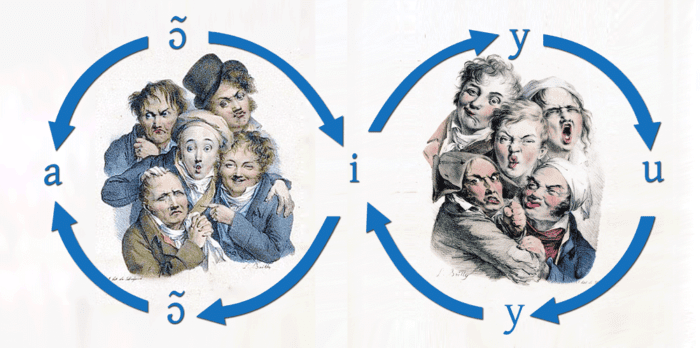Here’s an odd question: What if Speaking With Skill had been written specifically for French speakers (perhaps by Dudley “Chevalier”)? The “vowel calisthenics” figure-8 exercise beginning on page 279 might look something like this…try it out!
Does your mouth feel more French yet?
Sometimes coaching an accent’s posture can be challenging. Students may have different starting places, making relativity an issue. Describing the position of articulators can pose problems for students who can’t yet feel the movement or positioning of their vocal tract. In these cases, I remind myself that (oral/vocal tract) posture can be described not just in terms of a static resting position, but in terms of movement patterns.
One notable way French differs from English is in its inventory of vowel shapes. The French language has a greater ratio of front to back vowels and a greater number of vowels with lip rounding. French also has vowels produced with a low velum (nasal vowels). In the example exercise above, three out of five vowels are front vowels, three have lip rounding, and one is nasal. Two of the vowels ([ɔ̃] and [y]) have two of these features at the same time.
This movement pattern gets my tongue and lips moving independently of one another and mobilizes my soft palate. The frequent repetition of [i] reminds my tongue tip to stay down and positions the blade of my tongue for laminal consonants. The “outrigger” vowels [a] and [u] remind my mouth that not all features are used all the time. It’s a constellation of gestures much more characteristic of French than English. If I can hold on to the “feeling” of the exercise while speaking some text, I end up approximating the posture of a French accent whether I can verbally describe that posture or not.
Using these same vowel sounds, I can build a bridge between the exercise and a stable French posture in connected speech. For no other reason than the fact that three items are easier to remember than five, I might take the most frequent focal sounds from the exercise, ignoring the less frequent [a] and [u], and assign word tokens to them. With my student or client, I initiate an improvised “conversation” using these words, in varying combinations: perhaps French-accented music [ˈmyzik], business [ˈbiznɵs], and bond [bɔ̃d̬]*. From this posture-establishing exchange we can transition into scripted text or real conversation.
Does anyone else do something similar, perhaps with a different accent? Leave your pro tips in the comments!
*(I’m using the voiced diacritic in an unorthodox way here. French voice onset times are shorter than in English. Yes, /d/ is a voiced plosive in both languages, but as an English speaker in French mode, I want to remind myself to switch on the voice earlier than I might normally.)

